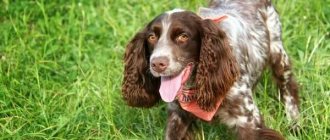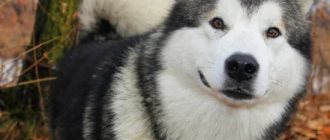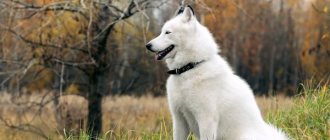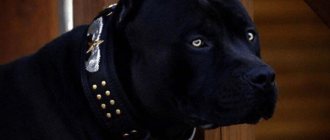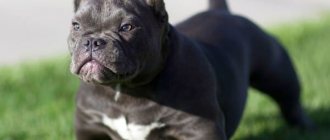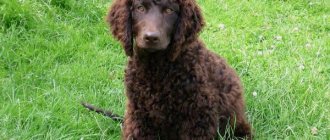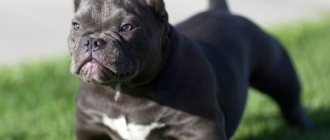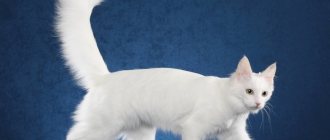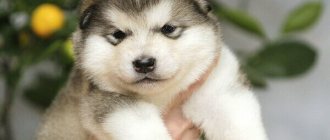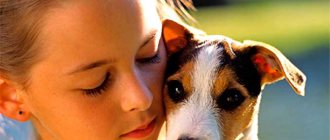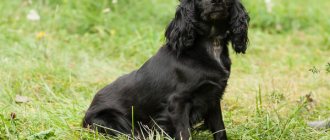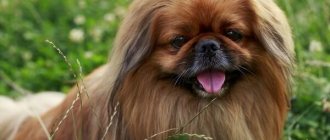Black Shiba Inus are less common than red dogs.
This color is highly valued among breeders precisely because it is less common.
And many potential owners of black Shiba Inu dream of such a pet precisely because this color is relatively rare.
What do those who are thinking about purchasing black Shibas need to know and what nuances need to be taken into account when keeping a dog of this breed in the house?
Origin story and what it looks like in the photo
The Shiba Inu is considered one of the most ancient Japanese dog breeds. Animals similar to modern Shiba appeared in Japan more than three thousand years ago.
Shibas were bred to guard Buddhist monasteries, whose inhabitants highly valued their dogs, and only later these dogs began to be used for hunting small game.
What was especially appreciated was the fact that they were not noisy: according to the monks, the absence of dog barking helped maintain silence and serene peace in the monasteries.
In most Japanese provinces in ancient times, dogs of a reddish or reddish color were bred, and only in the southwest of Honshu, in the San'in region, was preference given to dogs of black and white and black and tan color.
It was the dogs from this province that, apparently, became the main ancestors of modern black Shiba Inu.
Black and tan is considered one of the three coat colors allowed by the standard.
Expert opinion
Kozhevin Semyon Kirillovich
Expert dog handler.
Black Shiba Inus are rare: on average, their number in the population is about 20%. At the same time, not all of them meet the requirements for classic black Shibas. There should be a sufficient amount of red shades in the tan. Also required is the presence of urajiro: lightening of wool in the places specified by the standard. It is also very important that the mark on your Shiba’s chest is of the correct shape and resembles a butterfly in shape.
Character traits
Black Shiba Inus are a bit like cats in their character: they are also independent, attentive, careful and at the same time self-confident..
They love their owners, but in their own way: these dogs will definitely not obey their commands contrary to their interests or desires. Many owners consider this a manifestation of stubbornness or harmful character, but this is a completely different matter.
It’s just that the Shiba Inu, like most other Asian breeds, has its own opinion on everything and if it does not coincide with the owner’s, the dog will do as it sees fit.
However, if you raise and train your pet correctly, acting not with severity, but with kindness and affection, then you can achieve obedience from the Shiba Inu in almost any situation.
In Japan, the Shiba Inu is most valued for three qualities that these dogs have: good disposition, courageous audacity and simplicity.
Characteristics of puppies
Bitches of this breed are caring mothers. They usually have three puppies in a litter.
Already from three months, and sometimes earlier, the cub becomes clean. He will try to relieve himself only on the street and tolerate it at home. He strives for this himself; there is no need to teach him. After a couple of walks, he himself will ask to leave the house to go to the toilet.
IMPORTANT! Animals need to be taught order from a young age. Training is necessary; puppies must master at least basic commands: “Come”, “Place”, “No”. At the stage of 4-5 months, training can be weakened, replacing it with communication with other dogs. It is worth monitoring how actively the puppy is socialized - his comfortable communication with others will simplify life for both him and his owner.
Raising a Shiba Inu is an art. The Japanese compare this process to making origami: to achieve a good result, the owner will need patience, skill, perseverance and caution so as not to damage the fragile product. The ideal relationship with such a dog is a partnership where there is no rudeness or coercion.
Development
The first six months of a cub’s life can be called a period of intensive growth, then there is a noticeable inhibition, and by nine months it is completely completed. Below is a table of the relationship between the puppy's age and its weight.
| Age | Weight |
| 2 months | 3.2 kg |
| 3 months | 3.5 kg |
| 5 months | 4–5 kg |
| 7 months | 6–7 kg |
| 8 months | 8–10 kg |
It is worth keeping in mind that the values are averaged over the population (approximate) and can vary greatly between animals, because each person gains weight differently. To be one hundred percent sure of the health of your four-legged friend, you should consult a veterinarian.
Variability of color
Shibas are big deceivers; their color takes up to two years to develop. You can take a puppy with sesame color and get a red one, and vice versa. They also often have black faces. Most often they lighten, but sometimes the black fur can remain for life.
Black color options
Pure black
Most often, dogs of a black sesame color can look pure black, the fur of which has a very strong darkening, which is why the dog, especially in certain lighting, can look almost black.
True black Shiba Inus are even rarer and appear to be descendants of lines where there were once instances of interbreeding..
Black and Tan
This color resembles the color of a Rottweiler: with it, in places determined by the standard, golden-red markings are located on a basic black background.
The difference between a black and tan Rottweiler and a Shiba Inu of the same color is that the latter must have an urajiro.
Tricolor
This color is not recognized by the FCI standard . With this coloring, similar to black and tan, the dog also has white markings, making up no more than 50% of the total color.
Black and white
It can be observed with a very dark tan, in which the reddish markings are almost invisible. Moreover, these Shiba Inus have white markings.
All black colors except black and tan are considered plembraceous..
Advantages and disadvantages
pros:
- Well-developed guard instincts make Shiba Inu good guards.
- Rare color and exotic appearance.
- Well suited for keeping in an apartment.
- They can live in an enclosure or in the yard almost all year round.
- They don't smell.
- They are distinguished by intelligence, intelligence and at the same time very intelligent.
Minuses:
- When training, you have to look for an individual approach to training your pet.
- These dogs need quite a lot of exercise.
- Shiba Inus have a natural hunting instinct, which is why they can pose a danger to small animals and birds.
- Due to their inherent self-centeredness, Shiba Inus do not get along very well with other dogs.
Many representatives of this breed are quite picky eaters and need individual diets.
Education and training
Shiba Inus are naturally intelligent. But many inexperienced owners have the mistaken opinion that the breed is stupid. All due to the peculiar and stubborn nature of the dog.
The Japanese believe that raising a Shiba Inu puppy is like making origami. You need to put in a lot of diligence, patience and delicacy to get a well-mannered dog and not harm its psyche.
Shiba gives paw
They are involved in raising a puppy from the first days. It is almost impossible to retrain an adult dog. It is important to socialize the baby as early as possible, accustom him to human touch, wearing a leash and muzzle. The dog is at best not enthusiastic about all this.
Even experienced dog lovers who have never owned Japanese breeds before are advised to contact a dog trainer who knows how to work with Shiba Inu. Training is built on the basis of the pet’s natural curiosity, vigorously encouraging every success. Almost all punishments are prohibited, and the dog masterfully avoids them and quickly forgets them. The maximum is a stern look or intonation. Physical methods or cruelty will embitter the dog.
The difficulty is also associated with low food motivation. Shiba Inu cannot be bribed with treats. The dog does not refuse treats, but often it does not have the “correct behavior - reward” connection. The pet believes that they give her treats simply because she is so wonderful.
The only motivation for a Shiba to obey is complete trust and mutual respect with the owner. If the pet does not feel like an equal partner, it will not obey.
With owners who have found an approach to the breed, Shiba Inu master commands in a few minutes. But their implementation depends on the pet’s mood.
Jumping in competitions
With the right approach, Shiba Inu masters many sports disciplines: agility, tracking, freestyle, flyball, coursing, etc.
Dimensions, weight and other distinctive features
The table below shows the sizes of the Shiba Inu and a description of the standard of this breed.
| Options | Description |
| Dimensions | Males - 38 - 41 cm Bitches - 35 - 38 cm |
| Weight | Males - 10-13 kg Bitches - 7-9 kg |
| Body Format | In males it is 100:110, in females the body is slightly more stretched. |
| Head | Must be proportional to the body. The skull is quite wide, the transition to the muzzle is well defined. |
| Muzzle | Quite wide at the base and tapering towards the nose, the shape resembles a fox, but somewhat more voluminous. Its length is approximately 40% of the total length of the head. |
| Cheekbones | Moderately expressed. |
| Eyes | Triangular, medium-sized, slightly slanting. Eye color should be dark brown. |
| Ears | Triangular in shape, relatively small, quite dense. |
| Stomach | Moderately tucked in, not pulled in, but not saggy either. |
| Tail | Set high and quite thick at the base. Usually, it is either rolled into a ring or crescent-shaped |
| Wool | The so-called “wild” type, very dense and dense. The Shiba Inu's coat consists of a straight and harsh coat and a fairly soft and dense undercoat. The hair on the tail is longer than on the body and head. |
| Color | The only acceptable black color standard for Shiba Inu is considered to be black and tan coat color. |
IMPORTANT! With a black and tan color, a Shiba Inu must have urajiro - lightening to an almost white shade of hair on the back of the paws and tail, as well as on the neck, chest, cheekbones and muzzle.
Briefly about character and temperament
The Shiba Inu is a friendly but stubborn dog. At the same time, she is infinitely devoted to her owner, playful and cheerful. Sometimes she is compared to a cat for her love of freedom and independence. Owners often have difficulty getting used to a collar and leash.
Representatives of this breed are clean, well-trained, and intelligent . They are quite easy to accustom to order and walking routine.
In addition, Shiba Inus love to explore new things and sleep in unusual places. Sometimes a dog can climb onto a shelf or into a bookcase and fall asleep there.
Pets are also cunning and smart . They easily learn commands and understand them perfectly, but they don’t always “hear” them. The pet will follow commands only when it wishes.
The same applies to the owner’s demands; if the dog does not want to go somewhere, he will be capricious and resist like a child.
Life expectancy and what diseases are they susceptible to?
On average, dogs of this breed live from 12 to 15 years. Shiba Inus, as a rule, rarely get sick.
However, they have a breed predisposition to certain diseases, such as:
- Allergy
- Retinal atrophy
- von Willebrand disease
- Patella luxation
- Hypothyroidism
- Turn of the century
- Cataract
- Pyoderma
Shibs are very sensitive to infectious diseases, and therefore it is necessary to vaccinate on time.
White Shiba Inu
Albino Shiba Inu , a white beast of prey - looks amazing. A snow-white fox, a swift angel, an airy cloud. Fans of the “large prototype”, admirers of the magnificent Akita Inu, have “pushed” the new color into the register: large white huskies from the Japanese archipelago are strutting along the catwalks of the world.
Shiba Inus have not yet received a “federal blessing”: snow-white Shiba babies can only be considered as pets; the “Snow Whites” are not threatened with an exhibition career.
Basic rules of care
During shedding, black Shiba Inus need to be brushed daily; at other times, you can get by with less frequent brushing, for example, doing this procedure 2-3 times a week.
The Shiba Inu's coat has the property of self-cleaning, and since these dogs are very clean and rarely get dirty, they need to be washed no more than 2-3 times a year.
Eyes and ears are cleaned 3 times a month, but examined daily. The Shiba Inu's nails should be trimmed as needed.
Your pet's teeth can be cleaned using a special brush and toothpaste . But it's better to just let him chew on toys or treats to clean his teeth.
How to choose?
You should only buy a black Shiba Inu from a kennel or from a breeder recommended by the kennel club..
When choosing a Shiba Inu puppy, you need to pay attention to the brightness of its color and how proportional it looks.
IMPORTANT!
It is necessary to give preference to puppies with a strongly built, but not too squat body, a head commensurate with the body, a slightly shortened, pointed, but not narrow muzzle, with a tail of the correct shape and rather thick paws.
The puppy must be friendly towards people, and active, in addition, he must look well-groomed and be completely healthy.
Regarding color, I would like to note that it is best to take black Shiba Inu puppies with the brightest coat color and reddish rather than whitish tan.
Choosing and purchasing a Shiba Inu puppy
Shiba Inu puppies are expensive. This is due to small litters (on average 3 kittens are born), the popularity of the breed and difficulties in breeding. All purebred dogs with pedigrees are controlled by the Japanese organization Nippo. She keeps a register of each pet.
Important! If you need a dog with a pedigree for exhibitions or breeding, contact the breed club. There you can find out about the purebred of the baby: all puppies that meet the standard are registered in the Nippo database.
Choosing a puppy begins with choosing a breeder. Pay attention to the nursery's certificates, pedigrees and awards from the parents. You can ask for photographs of previous “pupils”.
Also pay attention to the conditions of detention. In addition to standard cleanliness and good feeding, it is important that dogs are kept indoors. This is due to breed characteristics: Shiba Inu do not like to contact people, so socialization from the first days of life is extremely necessary.
And, of course, meet the puppies. Play, try to treat and pet. Do not adopt cowardly or aggressive pets. Additionally, carefully examine the appearance of the children for compliance with the standards.
Puppies with colorful ribbons
The cost of a Shiba Inu puppy depends on its class:
- Pets of the pet class (with minor defects in appearance) are the cheapest to give away - 30–35 thousand rubles;
- the average cost for dogs of the breed class (used for breeding and work) is 40–60 thousand rubles;
- the highest price for show-class dogs (for exhibitions) is 70–90 thousand rubles.
There is no maximum price for puppies. Some nurseries sell pets for 120–150 thousand rubles and more.
Important! Do not take puppies that cost less than 30,000 rubles. As a rule, these are not purebred mestizos: you cannot vouch for their physical and mental health.
